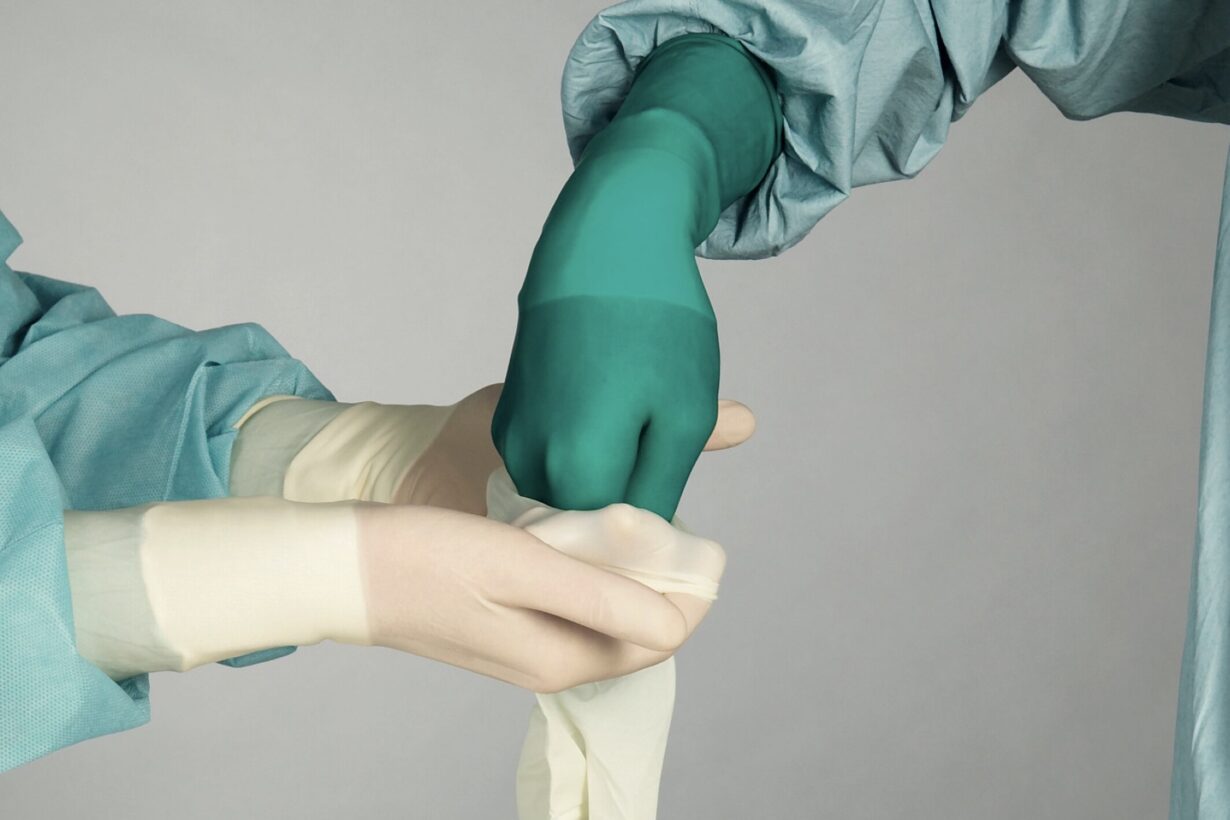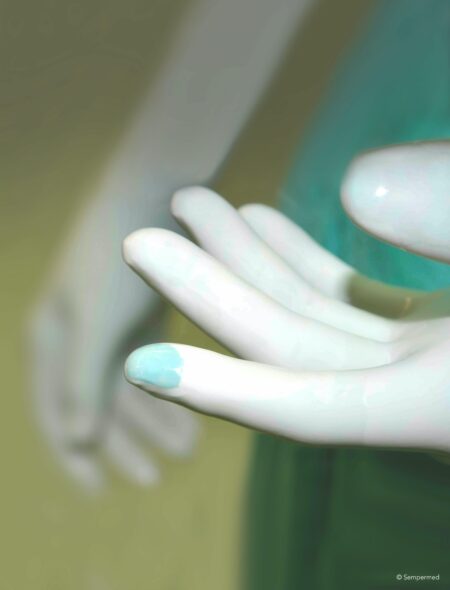Hand hygiene: “You have to use gloves correctly if you want to prevent infections.”
Along with hygienic hand disinfection, medical gloves are an essential measure for infection control – if used correctly.... read more

Every year more than half a million patients in Europe suffer surgical site infections (SSIs). Wearing two layers of surgical gloves, called double gloving, can reduce the risk of SSI and protects patients as well as healthcare staff. If damage to the top surgical glove occurs, an underglove provides a second barrier to contamination. But are two gloves really better than one? We look at the results of relevant studies.
During surgery, pathogens can transfer from the patient to the surgical staff and back to the patient again. The consequences of this contamination are often bloodborne infections, including surgical site infections (SSIs). According to the European Centre of Disease Prevention and Control (ECDC), half a million SSIs are reported annually in Europe alone1. As one way to prevent this pathogen transmission, medical professionals wear surgical gloves. These have the dual aim of preventing SSIs in patients while simultaneously protecting healthcare staff from contamination.
However, surgical teams are sometimes unaware when this barrier has been breached. For example, they might only notice after the surgical procedure that the patient’s blood is on their hands. But there is a way to make the barrier against transmitting pathogens twice as strong. By wearing two pairs of gloves on top of each other – known as double gloving – healthcare staff can reduce the chances of getting patient blood on their hands by up to 65 percent when the outer glove is punctured2.
For medical professionals, surgical gloves reduce the risk of contact with blood and other body fluids during surgery – thus reducing the risk of infections to their patients and to themselves. Through a thin layer of latex, vinyl, nitrile or other impermeable materials, surgical gloves provide a physical barrier to pathogens. Still, the question remains: Does wearing a single pair of surgical gloves offer enough protection?
A Cochrane review that included 34 randomised control trials with 6,890 person-operations determined that perforations of surgical gloves, whether worn alone or as part of a double gloving system, happen with approximately the same frequency, at 18.5 perforations per 100 person-operations3. However, the report confirms that despite damage to the upper surgical gloves, the underglove in a double gloving system shows perforations far less often. More than 17 percent of surgical gloves show perforations compared to six percent of the undergloves. This intact inner layer protects the wearer’s hands from contamination.

To alert wearers to damage in cases where surgical gloves have a hole, tear or microperforation, in many double gloving systems, the underglove is a vibrant hue – usually dark coloured such as green – while the surgical glove is generally white or light-coloured. This way, a coloured spot that is larger than the actual perforation will appear where liquid seeps in, and the spot helps staff to detect perforations faster and more frequently. In comparison, wearers of single surgical gloves notice perforations less often than staff using indicator systems, probably due to the lack of the signalling effect of the coloured underglove.4
As surgical staff handle “sharps” including needles, hooks, scissors, scalpels and other bladed instruments, damage to gloves and injury to hands is not uncommon. Almost all surgeons experience needle-stick injuries during their careers5. In another example, damage to surgical gloves – with the accompanying risk of infection for patient and healthcare staff – occurs in 15 percent of orthopaedic procedures on average, where the mechanical stress is particularly high6.
In fact, while the protection offered by surgical gloves decreases over time, particularly during operations that last more than three hours, the rate of microperforations gradually increases due to the mechanical stress of handling surgical instruments7. Wearing two pairs of surgical gloves offers the same physical barrier as wearing surgical gloves over brightly-coloured undergloves. However, the indicator systems and brightly-coloured undergloves offer distinct advantages when double gloving, as at least one recent investigation has shown.

A 2014 multicentre study in the United States compared the use of surgical gloves worn alone, double gloving with the same-coloured surgical gloves, and double gloving with green indicator undergloves8. The researchers also evaluated the durability of the undergloves, and whether or not wearers noticed damage to their surgical gloves during the procedures.
More than 700 healthcare professionals participated in the study. To evaluate the benefits of double gloving, the researchers collected and examined almost 38,000 gloves from over 4,500 procedures. When participants were asked whether or not they felt needle sticks, no significant difference was found between the surgical glove and double gloving groups. But more of the medical staff members wearing surgical gloves alone discovered blood on their hands later.
These wearers also had a higher frequency of holes, tears or microperforations in their surgical gloves compared to similar damage to the undergloves in the other two groups. In addition, staff members using the indicator glove system changed gloves more often during surgery than those using double gloving without an indicator system. In fact, the double gloving colour indicator system significantly increased awareness of glove defects among the surgical team members.
One significant question remains on whether healthcare staff find the double glove system restrictive. For example, it remains to be understood if wearing two pairs of gloves affect sensitivity and dexterity of the hands during surgery. Still, the majority of surgeons did not report limitations to their work efficiency, which shows a high acceptance rate for double gloving.
In all medical situations, preventing infection and protecting healthcare staff during surgery begins with high-quality surgical gloves. To meet this requirement, manufacturers test medical and surgical gloves extensively during production and before shipment9. In the pinhole leak test, for example, which is based on the standards of the American Society for Testing and Materials10 and regulated by the US Food and Drug Administration, a sample of gloves from each batch are filled with water. They are then secured at the cuff and hung upside down for two minutes to determine if they retain the water. These tests allow manufacturers to determine whether the gloves are impermeable, or, in other words, free from microperforations that could let pathogens through.
In Europe, disposable medical gloves are manufactured according to the ISO EN 455 standard11. This stipulates that such gloves should pass a watertight test, where they are filled with one litre of water and checked after a specific time for leakages with an acceptable quality level (AQL) of 1.5. This testing means that statistically fewer than 1.5 percent of gloves in the batch have defects. Manufacturers of surgical gloves follow these strict guidelines to ensure that the gloves they supply are in perfect condition, but a small percentage of microperforations cannot be avoided. Most suppliers of high quality surgical gloves achieve an AQL of 0.65 and therefore enhance protection by exceeding the required standards.
Here, also, double gloving provides a second line of defence: Undergloves protect their wearers as well as the patients should microperforations be present in the surgical gloves even when no damage is visible.
As double gloving has proved its value in numerous studies, professional organisations such as the Germany’s Robert Koch Institute (RKI)12, the Association of the Scientific Medical Societies in Germany (Arbeitsgemeinschaft der Wissenschaftlichen Medizinischen Fachgesellschaften e.V., AWMF)13, the US Centers for Disease Control and Prevention (CDC), and the US-based Association of periOperative Registered Nurses (AORN)14 recommend double gloving, in particular during surgeries with a high risk of injury, infection, or perforation such as orthopaedic, gastrointestinal, trauma and emergency procedures. They also advise staff to immediately change gloves that are damaged during surgery as soon as the damage is detected.
By making the barrier between hands and surgical wounds less permeable, double gloving raises the barrier to contamination and lowers the risk of infection. With strong evidence to support the benefits, many surgical teams worldwide are already routinely donning two pair of gloves, to form an inner and outer layer of protection during surgery. Double gloving safeguards patients from SSI and protects healthcare staff – by making it twice as difficult for pathogens to get through.
FURTHER INFORMATION
Empfehlungen zur Händehygiene in Einrichtungen des Gesundheitswesens, Robert Koch Institut